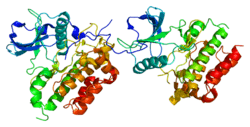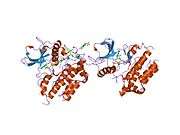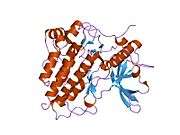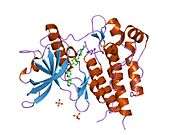CD117
Mast/stem cell growth factor receptor (SCFR), also known as proto-oncogene c-Kit or tyrosine-protein kinase Kit or CD117, is a receptor tyrosine kinase protein that in humans is encoded by the KIT gene.[3] Multiple transcript variants encoding different isoforms have been found for this gene.[4][5] KIT was first described by the German biochemist Axel Ullrich in 1987 as the cellular homolog of the feline sarcoma viral oncogene v-kit.[6]
Cell surface marker
Cluster of differentiation (CD) molecules are markers on the cell surface, as recognized by specific sets of antibodies, used to identify the cell type, stage of differentiation and activity of a cell. CD117 is an important cell surface marker used to identify certain types of hematopoietic (blood) progenitors in the bone marrow. To be specific, hematopoietic stem cells (HSC), multipotent progenitors (MPP), and common myeloid progenitors (CMP) express high levels of CD117. Common lymphoid progenitors (CLP) express low surface levels of CD117. CD117 also identifies the earliest thymocyte progenitors in the thymus. To be specific, early T lineage progenitors (ETP/DN1) and DN2 thymocytes express high levels of c-Kit. It is also a marker for mouse prostate stem cells.[7] In addition, mast cells, melanocytes in the skin, and interstitial cells of Cajal in the digestive tract express CD117.
Function
CD117 is a cytokine receptor expressed on the surface of hematopoietic stem cells as well as other cell types. Altered forms of this receptor may be associated with some types of cancer.[8] CD117 is a receptor tyrosine kinase type III, which binds to stem cell factor (a substance that causes certain types of cells to grow), also known as "steel factor" or "c-kit ligand". When this receptor binds to stem cell factor (SCF) it forms a dimer that activates its intrinsic tyrosine kinase activity, that in turn phosphorylates and activates signal transduction molecules that propagate the signal in the cell. Signalling through CD117 plays a role in cell survival, proliferation, and differentiation.
Mobilization
Hematopoietic progenitor cells are normally present in the blood at low levels. Mobilization is the process by which progenitors are made to migrate from the bone marrow into the bloodstream, thus increasing their numbers in the blood. Mobilization is used clinically as a source of hematopoietic stem cells for hematopoietic stem cell transplantation (HSCT). Signaling through CD117 has been implicated in mobilization. At the current time, G-CSF is the main drug used for mobilization; it indirectly activates CD117. Plerixafor (an antagonist of CXCR4-SDF1) in combination with G-CSF, is also being used for mobilization of hematopoietic progenitor cells. Direct CD117 agonists are currently being developed as mobilization agents.
Role in cancer
Activating mutations in this gene are associated with gastrointestinal stromal tumors, testicular seminoma, mast cell disease, melanoma, acute myeloid leukemia, while inactivating mutations are associated with the genetic defect piebaldism.[4]
Anti-KIT therapies
CD117 is a proto-oncogene, meaning that overexpression or mutations of this protein can lead to cancer.[9] Seminomas, a subtype of testicular germ cell tumors, frequently have activating mutations in exon 17 of CD117. In addition, the gene encoding CD117 is frequently overexpressed and amplified in this tumor type, most commonly occurring as a single gene amplicon.[10] Mutations of CD117 have also been implicated in leukemia, a cancer of hematopoietic progenitors, melanoma, mast cell disease, and gastrointestinal stromal tumors (GISTs). The efficacy of imatinib (trade name Gleevec), a CD117 inhibitor, is determined by the mutation status of CD117:
When the mutation has occurred in exon 11 (as is the case many times in GISTs), the tumors are responsive to imatinib. However, if the mutation occurs in exon 17 (as is often the case in seminomas and leukemias), the receptor is not inhibited by imatinib. In those cases other inhibitors such as dasatinib and nilotinib can be used. Researchers investigated the dynamic behavior of wild type and mutant D816H KIT receptor, and emphasized the extended A-loop (EAL) region (805-850) by conducting computational analysis.[11] Their atomic investigation of mutant KIT receptor which emphasized on the EAL region provided a better insight into the understanding of the sunitinib resistance mechanism of the KIT receptor and could help to discover new therapeutics for KIT-based resistant tumor cells in GIST therapy.[11]
The preclinical agent, KTN0182A, is an anti-KIT, Pyrrolobenzodiazepine (PBD)-containing antibody-drug conjugate which shows anti-tumor activity in vitro and in vivo against a range of tumor types. [12]
Diagnostic relevance
Antibodies to CD117 are widely used in immunohistochemistry to help distinguish particular types of tumour in histological tissue sections. It is used primarily in the diagnosis of GISTs, which are positive for CD117, but negative for markers such as desmin and S-100, which are positive in smooth muscle and neural tumors, which have a similar appearance. In GISTs, CD117 staining is typically cytoplasmic, with stronger accentuation along the cell membranes. CD117 antibodies can also be used in the diagnosis of mast cell tumours and in distinguishing seminomas from embryonal carcinomas.[13]
Interactions
CD117 has been shown to interact with:
See also
References
- ↑ "Human PubMed Reference:".
- ↑ "Mouse PubMed Reference:".
- ↑ Andre C, Hampe A, Lachaume P, Martin E, Wang XP, Manus V, Hu WX, Galibert F (January 1997). "Sequence analysis of two genomic regions containing the KIT and the FMS receptor tyrosine kinase genes". Genomics. 39 (2): 216–26. PMID 9027509. doi:10.1006/geno.1996.4482.
- 1 2 "Entrez Gene: KIT v-kit Hardy-Zuckerman 4 feline sarcoma viral oncogene homolog".
- ↑ National Cancer Institute Dictionary of Cancer Terms. c-kit. Accessed October 13, 2014.
- ↑ Yarden Y, Kuang WJ, Yang-Feng T, Coussens L, Munemitsu S, Dull TJ, Chen E, Schlessinger J, Francke U, Ullrich A (November 1987). "Human proto-oncogene c-kit: a new cell surface receptor tyrosine kinase for an unidentified ligand". EMBO J. 6 (11): 3341–51. PMC 553789
 . PMID 2448137.
. PMID 2448137. - ↑ Leong KG, Wang BE, Johnson L, Gao WQ (October 2008). "Generation of a prostate from a single adult stem cell". Nature. 456 (7223): 804–8. PMID 18946470. doi:10.1038/nature07427.
- ↑ Edling CE, Hallberg B (2007). "c-Kit--a hematopoietic cell essential receptor tyrosine kinase". Int. J. Biochem. Cell Biol. 39 (11): 1995–8. PMID 17350321. doi:10.1016/j.biocel.2006.12.005.
- ↑ Jean-Loup Huret. "KIT". Atlas of Genetics and Cytogenetics in Oncology and Haematology. Retrieved 2008-03-01.
- ↑ McIntyre A, Summersgill B, Grygalewicz B, Gillis AJ, Stoop J, van Gurp RJ, Dennis N, Fisher C, Huddart R, Cooper C, Clark J, Oosterhuis JW, Looijenga LH, Shipley J (2005). "Amplification and overexpression of the KIT gene is associated with progression in the seminoma subtype of testicular germ cell tumors of adolescents and adults". Cancer Res. 65 (18): 8085–9. PMID 16166280. doi:10.1158/0008-5472.CAN-05-0471.
- 1 2 Purohit R (2014). "Role of ELA region in auto-activation of mutant KIT receptor: a molecular dynamics simulation insight". Journal of Biomolecular Structure & Dynamics. 32 (7): 1033–46. PMID 23782055. doi:10.1080/07391102.2013.803264.
- ↑ KTN0182A, an Anti-KIT, Pyrrolobenzodiazepine (PBD)-Containing Antibody Drug Conjugate (ADC) Demonstrates Potent Antitumor Activity In Vitro and In Vivo Against a Broad Range of Tumor Types; Lubeski C, Kemp GC, Von Bulow CL, Howard PW, Hartley JA, Douville T, Wellbrock J, et al.; 11th Annual PEGS - The Essential Protein Engineering Summit, Boston, 2015 Archived October 30, 2015, at the Wayback Machine.
- ↑ Leong, Anthony S-Y; Cooper, Kumarason; Leong, F Joel W-M (2003). Manual of Diagnostic Cytology (2 ed.). Greenwich Medical Media, Ltd. pp. 149–151. ISBN 1-84110-100-1.
- ↑ Wollberg P, Lennartsson J, Gottfridsson E, Yoshimura A, Rönnstrand L (March 2003). "The adapter protein APS associates with the multifunctional docking sites Tyr-568 and Tyr-936 in c-Kit". Biochem. J. 370 (Pt 3): 1033–8. PMC 1223215
 . PMID 12444928. doi:10.1042/BJ20020716.
. PMID 12444928. doi:10.1042/BJ20020716. - ↑ Hallek M, Danhauser-Riedl S, Herbst R, Warmuth M, Winkler A, Kolb HJ, Druker B, Griffin JD, Emmerich B, Ullrich A (July 1996). "Interaction of the receptor tyrosine kinase p145c-kit with the p210bcr/abl kinase in myeloid cells". Br. J. Haematol. 94 (1): 5–16. PMID 8757502. doi:10.1046/j.1365-2141.1996.6102053.x.
- 1 2 3 Anzai N, Lee Y, Youn BS, Fukuda S, Kim YJ, Mantel C, Akashi M, Broxmeyer HE (June 2002). "C-kit associated with the transmembrane 4 superfamily proteins constitutes a functionally distinct subunit in human hematopoietic progenitors". Blood. 99 (12): 4413–21. PMID 12036870. doi:10.1182/blood.V99.12.4413.
- 1 2 Lennartsson J, Wernstedt C, Engström U, Hellman U, Rönnstrand L (August 2003). "Identification of Tyr900 in the kinase domain of c-Kit as a Src-dependent phosphorylation site mediating interaction with c-Crk". Exp. Cell Res. 288 (1): 110–8. PMID 12878163. doi:10.1016/S0014-4827(03)00206-4.
- 1 2 van Dijk TB, van Den Akker E, Amelsvoort MP, Mano H, Löwenberg B, von Lindern M (November 2000). "Stem cell factor induces phosphatidylinositol 3'-kinase-dependent Lyn/Tec/Dok-1 complex formation in hematopoietic cells". Blood. 96 (10): 3406–13. PMID 11071635.
- ↑ Sattler M, Salgia R, Shrikhande G, Verma S, Pisick E, Prasad KV, Griffin JD (April 1997). "Steel factor induces tyrosine phosphorylation of CRKL and binding of CRKL to a complex containing c-kit, phosphatidylinositol 3-kinase, and p120(CBL)". J. Biol. Chem. 272 (15): 10248–53. PMID 9092574. doi:10.1074/jbc.272.15.10248.
- 1 2 Liang X, Wisniewski D, Strife A, Clarkson B, Resh MD (April 2002). "Phosphatidylinositol 3-kinase and Src family kinases are required for phosphorylation and membrane recruitment of Dok-1 in c-Kit signaling". J. Biol. Chem. 277 (16): 13732–8. PMID 11825908. doi:10.1074/jbc.M200277200.
- 1 2 Voisset E, Lopez S, Chaix A, Vita M, George C, Dubreuil P, De Sepulveda P (February 2010). "FES kinase participates in KIT-ligand induced chemotaxis". Biochem. Biophys. Res. Commun. 393 (1): 174–8. PMID 20117079. doi:10.1016/j.bbrc.2010.01.116.
- ↑ Jahn T, Seipel P, Urschel S, Peschel C, Duyster J (February 2002). "Role for the adaptor protein Grb10 in the activation of Akt". Mol. Cell. Biol. 22 (4): 979–91. PMC 134632
 . PMID 11809791. doi:10.1128/MCB.22.4.979-991.2002.
. PMID 11809791. doi:10.1128/MCB.22.4.979-991.2002. - 1 2 3 De Sepulveda P, Okkenhaug K, Rose JL, Hawley RG, Dubreuil P, Rottapel R (February 1999). "Socs1 binds to multiple signalling proteins and suppresses steel factor-dependent proliferation". EMBO J. 18 (4): 904–15. PMC 1171183
 . PMID 10022833. doi:10.1093/emboj/18.4.904.
. PMID 10022833. doi:10.1093/emboj/18.4.904. - ↑ Thömmes K, Lennartsson J, Carlberg M, Rönnstrand L (July 1999). "Identification of Tyr-703 and Tyr-936 as the primary association sites for Grb2 and Grb7 in the c-Kit/stem cell factor receptor". Biochem. J. 341 (1): 211–6. PMC 1220349
 . PMID 10377264. doi:10.1042/0264-6021:3410211.
. PMID 10377264. doi:10.1042/0264-6021:3410211. - ↑ Feng GS, Ouyang YB, Hu DP, Shi ZQ, Gentz R, Ni J (May 1996). "Grap is a novel SH3-SH2-SH3 adaptor protein that couples tyrosine kinases to the Ras pathway". J. Biol. Chem. 271 (21): 12129–32. PMID 8647802. doi:10.1074/jbc.271.21.12129.
- ↑ Lev S, Yarden Y, Givol D (May 1992). "A recombinant ectodomain of the receptor for the stem cell factor (SCF) retains ligand-induced receptor dimerization and antagonizes SCF-stimulated cellular responses". J. Biol. Chem. 267 (15): 10866–73. PMID 1375232.
- ↑ Blechman JM, Lev S, Brizzi MF, Leitner O, Pegoraro L, Givol D, Yarden Y (February 1993). "Soluble c-kit proteins and antireceptor monoclonal antibodies confine the binding site of the stem cell factor". J. Biol. Chem. 268 (6): 4399–406. PMID 7680037.
- ↑ Gueller S, Gery S, Nowak V, Liu L, Serve H, Koeffler HP (October 2008). "Adaptor protein Lnk associates with Tyr(568) in c-Kit". Biochem. J. 415 (2): 241–5. PMID 18588518. doi:10.1042/BJ20080102.
- ↑ Linnekin D, DeBerry CS, Mou S (October 1997). "Lyn associates with the juxtamembrane region of c-Kit and is activated by stem cell factor in hematopoietic cell lines and normal progenitor cells". J. Biol. Chem. 272 (43): 27450–5. PMID 9341198. doi:10.1074/jbc.272.43.27450.
- ↑ Jhun BH, Rivnay B, Price D, Avraham H (April 1995). "The MATK tyrosine kinase interacts in a specific and SH2-dependent manner with c-Kit". J. Biol. Chem. 270 (16): 9661–6. PMID 7536744. doi:10.1074/jbc.270.16.9661.
- ↑ Price DJ, Rivnay B, Fu Y, Jiang S, Avraham S, Avraham H (February 1997). "Direct association of Csk homologous kinase (CHK) with the diphosphorylated site Tyr568/570 of the activated c-KIT in megakaryocytes". J. Biol. Chem. 272 (9): 5915–20. PMID 9038210. doi:10.1074/jbc.272.9.5915.
- ↑ Mancini A, Koch A, Stefan M, Niemann H, Tamura T (September 2000). "The direct association of the multiple PDZ domain containing proteins (MUPP-1) with the human c-Kit C-terminus is regulated by tyrosine kinase activity". FEBS Lett. 482 (1-2): 54–8. PMID 11018522. doi:10.1016/S0014-5793(00)02036-6.
- ↑ Serve H, Hsu YC, Besmer P (February 1994). "Tyrosine residue 719 of the c-kit receptor is essential for binding of the P85 subunit of phosphatidylinositol (PI) 3-kinase and for c-kit-associated PI 3-kinase activity in COS-1 cells". J. Biol. Chem. 269 (8): 6026–30. PMID 7509796.
- ↑ Tauchi T, Feng GS, Marshall MS, Shen R, Mantel C, Pawson T, Broxmeyer HE (October 1994). "The ubiquitously expressed Syp phosphatase interacts with c-kit and Grb2 in hematopoietic cells". J. Biol. Chem. 269 (40): 25206–11. PMID 7523381.
- 1 2 Kozlowski M, Larose L, Lee F, Le DM, Rottapel R, Siminovitch KA (April 1998). "SHP-1 binds and negatively modulates the c-Kit receptor by interaction with tyrosine 569 in the c-Kit juxtamembrane domain". Mol. Cell. Biol. 18 (4): 2089–99. PMC 121439
 . PMID 9528781.
. PMID 9528781. - ↑ Yi T, Ihle JN (June 1993). "Association of hematopoietic cell phosphatase with c-Kit after stimulation with c-Kit ligand". Mol. Cell. Biol. 13 (6): 3350–8. PMC 359793
 . PMID 7684496.
. PMID 7684496. - ↑ Deberry C, Mou S, Linnekin D (October 1997). "Stat1 associates with c-kit and is activated in response to stem cell factor". Biochem. J. 327 (1): 73–80. PMC 1218765
 . PMID 9355737.
. PMID 9355737. - ↑ Bayle J, Letard S, Frank R, Dubreuil P, De Sepulveda P (March 2004). "Suppressor of cytokine signaling 6 associates with KIT and regulates KIT receptor signaling". J. Biol. Chem. 279 (13): 12249–59. PMID 14707129. doi:10.1074/jbc.M313381200.
- ↑ Lennartsson J, Blume-Jensen P, Hermanson M, Pontén E, Carlberg M, Rönnstrand L (September 1999). "Phosphorylation of Shc by Src family kinases is necessary for stem cell factor receptor/c-kit mediated activation of the Ras/MAP kinase pathway and c-fos induction". Oncogene. 18 (40): 5546–53. PMID 10523831. doi:10.1038/sj.onc.1202929.
- ↑ Tang B, Mano H, Yi T, Ihle JN (December 1994). "Tec kinase associates with c-kit and is tyrosine phosphorylated and activated following stem cell factor binding". Mol. Cell. Biol. 14 (12): 8432–7. PMC 359382
 . PMID 7526158.
. PMID 7526158.
Further reading
- Lennartsson J, Rönnstrand L (2012). "Stem cell factor receptor/c-Kit: from basic science to clinical implications.". Physiol. Rev. 92 (4): 1619–49. PMID 23073628. doi:10.1152/physrev.00046.2011.
- Lennartsson J, Rönnstrand L (2006). "The stem cell factor receptor/c-Kit as a drug target in cancer". Curr. Cancer Drug Targ. 6 (1): 65–75. PMID 16475976. doi:10.2174/156800906775471725.
- Rönnstrand L (2004). "Signal transduction via the stem cell factor receptor/c-Kit". Cell. Mol. Life Sci. 61 (19–20): 2535–2548. PMID 15526160. doi:10.1007/s00018-004-4189-6.
- Linnekin D (2000). "Early signaling pathways activated by c-Kit in hematopoietic cells". Int. J. Biochem. Cell Biol. 31 (10): 1053–74. PMID 10582339. doi:10.1016/S1357-2725(99)00078-3.
- Canonico B, Felici C, Papa S (2001). "CD117". J. Biol. Regul. Homeost. Agents. 15 (1): 90–4. PMID 11388751.
- Gupta R, Bain BJ, Knight CL (2002). "Cytogenetic and molecular genetic abnormalities in systemic mastocytosis". Acta Haematol. 107 (2): 123–8. PMID 11919394. doi:10.1159/000046642.
- Valent P, Ghannadan M, Hauswirth AW, Schernthaner GH, Sperr WR, Arock M (2003). "Signal transduction-associated and cell activation-linked antigens expressed in human mast cells". Int. J. Hematol. 75 (4): 357–62. PMID 12041664. doi:10.1007/BF02982124.
- Sandberg AA, Bridge JA (2002). "Updates on the cytogenetics and molecular genetics of bone and soft tissue tumors. gastrointestinal stromal tumors". Cancer Genet. Cytogenet. 135 (1): 1–22. PMID 12072198. doi:10.1016/S0165-4608(02)00546-0.
- Kitamura Y, Hirotab S (2005). "Kit as a human oncogenic tyrosine kinase". Cell. Mol. Life Sci. 61 (23): 2924–31. PMID 15583854. doi:10.1007/s00018-004-4273-y.
- Larizza L, Magnani I, Beghini A (2005). "The Kasumi-1 cell line: a t(8;21)-kit mutant model for acute myeloid leukemia". Leuk. Lymphoma. 46 (2): 247–55. PMID 15621809. doi:10.1080/10428190400007565.
- Miettinen M, Lasota J (2006). "KIT (CD117): a review on expression in normal and neoplastic tissues, and mutations and their clinicopathologic correlation". Appl. Immunohistochem. Mol. Morphol. 13 (3): 205–20. PMID 16082245. doi:10.1097/01.pai.0000173054.83414.22.
- Lasota J, Miettinen M (2007). "KIT and PDGFRA mutations in gastrointestinal stromal tumors (GISTs)". Semin Diagn Pathol. 23 (2): 91–102. PMID 17193822. doi:10.1053/j.semdp.2006.08.006.
- Patnaik MM, Tefferi A, Pardanani A (2007). "Kit: molecule of interest for the diagnosis and treatment of mastocytosis and other neoplastic disorders". Current cancer drug targets. 7 (5): 492–503. PMID 17691909. doi:10.2174/156800907781386614.
- Giebel LB, Strunk KM, Holmes SA, Spritz RA (1992). "Organization and nucleotide sequence of the human KIT (mast/stem cell growth factor receptor) proto-oncogene". Oncogene. 7 (11): 2207–17. PMID 1279499.
- Spritz RA, Droetto S, Fukushima Y (1992). "Deletion of the KIT and PDGFRA genes in a patient with piebaldism". Am. J. Med. Genet. 44 (4): 492–5. PMID 1279971. doi:10.1002/ajmg.1320440422.
- Spritz RA, Giebel LB, Holmes SA (1992). "Dominant negative and loss of function mutations of the c-kit (mast/stem cell growth factor receptor) proto-oncogene in human piebaldism". Am. J. Hum. Genet. 50 (2): 261–9. PMC 1682440
 . PMID 1370874.
. PMID 1370874. - Duronio V, Welham MJ, Abraham S, Dryden P, Schrader JW (1992). "p21ras activation via hemopoietin receptors and c-kit requires tyrosine kinase activity but not tyrosine phosphorylation of p21ras GTPase-activating protein". Proc. Natl. Acad. Sci. U.S.A. 89 (5): 1587–91. PMC 48497
 . PMID 1371879. doi:10.1073/pnas.89.5.1587.
. PMID 1371879. doi:10.1073/pnas.89.5.1587. - André C, Martin E, Cornu F, Hu WX, Wang XP, Galibert F (1992). "Genomic organization of the human c-kit gene: evolution of the receptor tyrosine kinase subclass III". Oncogene. 7 (4): 685–91. PMID 1373482.
- Lev S, Yarden Y, Givol D (1992). "A recombinant ectodomain of the receptor for the stem cell factor (SCF) retains ligand-induced receptor dimerization and antagonizes SCF-stimulated cellular responses". J. Biol. Chem. 267 (15): 10866–73. PMID 1375232.
- Fleischman RA (1992). "Human piebald trait resulting from a dominant negative mutant allele of the c-kit membrane receptor gene". J. Clin. Invest. 89 (6): 1713–7. PMC 295855
 . PMID 1376329. doi:10.1172/JCI115772.
. PMID 1376329. doi:10.1172/JCI115772. - Vandenbark GR, deCastro CM, Taylor H, Dew-Knight S, Kaufman RE (1992). "Cloning and structural analysis of the human c-kit gene". Oncogene. 7 (7): 1259–66. PMID 1377810.
- Alai M, Mui AL, Cutler RL, Bustelo XR, Barbacid M, Krystal G (1992). "Steel factor stimulates the tyrosine phosphorylation of the proto-oncogene product, p95vav, in human hemopoietic cells". J. Biol. Chem. 267 (25): 18021–5. PMID 1381360.
- Ashman LK, Cambareri AC, To LB, Levinsky RJ, Juttner CA (1991). "Expression of the YB5.B8 antigen (c-kit proto-oncogene product) in normal human bone marrow". Blood. 78 (1): 30–7. PMID 1712644.
External links
- Proto-Oncogene Proteins c-kit at the US National Library of Medicine Medical Subject Headings (MeSH)
- C-kit receptor entry in the public domain NCI Dictionary of Cancer Terms
- Human KIT genome location and KIT gene details page in the UCSC Genome Browser.



